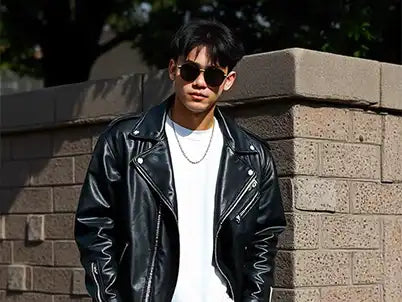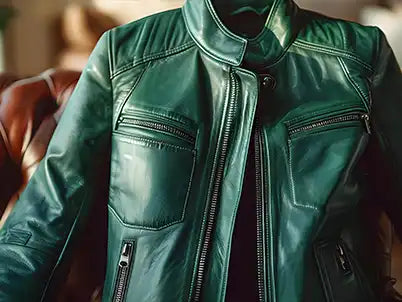There’s something about a leather biker jacket that feels different from anything else you own. But leather doesn’t take care of itself. If you don’t give it attention, it’ll dry out, lose shape, and stop looking like the jacket you fell in love with. When you’ve spent good money on men’s biker jackets, the last thing you want is to see cracks forming after a year. Luckily, keeping them in good shape isn’t as hard as it sounds. It’s more about small habits than complicated routines.
Get to Know the Leather Biker Jacket

Not all leather is the same. Cowhide, lambskin, goatskin, buffalo—they all wear differently.
- Cowhide: heavy, tough, and built for road protection.
- Lambskin: soft, smooth, perfect for fashion, but scratches easily.
- Goatskin: somewhere in between—grainy texture, flexible, and long-lasting.
- Shearling: leather plus wool lining, so you’re caring for two materials at once.
Why does this matter? Because what works for a cowhide biker jacket might overwhelm delicate lambskin. I once conditioned a lambskin jacket with the same heavy cream I used on cowhide, and it ended up darker and greasier.
Cleaning Without Overdoing It

Leather isn’t denim, so you don’t toss it in the wash. It doesn’t like too much water or soap. Follow these tips to wash a motorcycle jacket.
- Dust it off with a soft cloth after wearing.
- If you spill something, dab it gently with a damp cloth. Don’t scrub, it just spreads the stain.
- For bigger messes, a little mild soap mixed with water works, but go light.
I once over-cleaned my tan jacket after a coffee accident, and the patch ended up lighter than the rest. Honestly, a small stain would’ve looked better.
Why Conditioning Matters

Think of conditioning like skincare. If you never moisturize, your skin dries out. Same with leather.
- Use conditioner a few times a year, maybe more if you live somewhere dry.
- Apply with a cloth, small amounts at a time.
- Always test on a hidden spot first—some products darken the leather.
I kind of enjoy this step. Rubbing conditioner into an old jacket and seeing it come back to life feels like reviving an old friend.
Store It Like You Care

Hanging your jacket on a wire hanger? That’s how you ruin the shoulders.
- Use a wide, padded hanger.
- Skip plastic covers—leather needs air. Use a cloth bag if you want to protect it.
- Keep it somewhere cool and dry, not near heaters or in damp basements.
I left a jacket near a radiator once. The sleeves went stiff and cracked. Still hurts to think about it.
Handling Rain (Because It Happens)

Rain and leather don’t mix well, but life happens.
- Hang it to dry naturally, away from heaters or sunlight.
- While it dries, shape the arms so they don’t harden funny.
- Once dry, condition it to restore oils.
Don’t panic if it gets wet once. Just don’t make it a habit.
When It Starts to Smell

Leather can pick up odors—smoke, food, or just everyday wear.
- Hang it outside on a dry day (shade, not direct sun).
- Put it in a breathable bag with an open box of baking soda for a couple of days.
- Use leather sprays sparingly—sometimes they’re stronger than the problem.
My barbecue jacket smelled like smoke for weeks. Baking soda worked better than any spray I tried.
Scuffs, Scratches, and “Character”

Part of the charm is how a biker jacket ages. Light scuffs add character. Deep scratches? Not so much.
- For light ones, rub gently with your fingers—the oils in your skin sometimes help.
- For deeper marks, use a little conditioner to blend them.
- Don’t chase perfection. A few scars make it yours.
Honestly, the scuffed-up jacket I’ve had for ten years looks way better than my newer ones.
Seasonal Habits

Leather has seasons too.
- Winter: shearling-lined jackets need shaking out and extra care.
- Summer: Don’t leave them in a hot car.
- Spring/Fall: Prime wearing season, condition before and after heavy use.
Rotating jackets also gives each one a break, which extends their life. Plus, it’s an excuse to own more than one.
When to Call in the Pros

Some stuff you just can’t fix at home. Deep stains, torn lining, faded color—a leather specialist is worth it. They can clean, repair, and re-dye jackets. It’s not cheap, but neither was your jacket.
I sent in an old rider once that I thought was finished. It came back looking almost new but still had that worn-in feel. Totally worth it.
Build Simple Habits

The best care isn’t complicated—it’s consistent. Wipe it down after wearing, hang it properly, and condition it every so often. Those little habits keep it looking good for decades.
Think of it less as “maintenance” and more as part of owning leather.




















